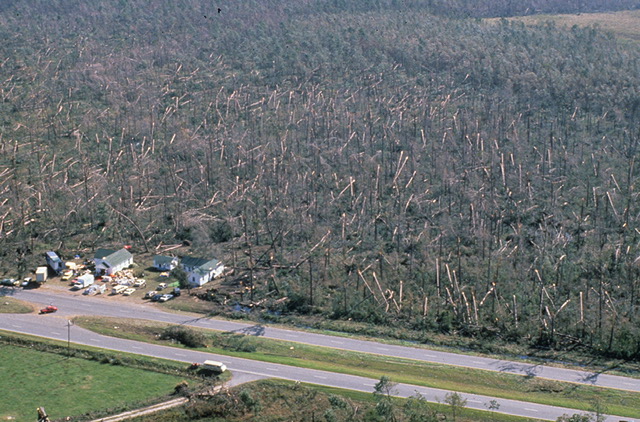Hurricane Hugo
Alumni Robert John Gould tells the devastating story of Hurricane Hugo in 1989.

My name is Robert John Gould and I am a 1955 Forestry graduate of Michigan State University. I was drafted and spent two years in the US Army at Redstone Arsenal and was honorably discharged from the army in December 1957. This is when I began the search of how to put my Forestry degree to work.
I was first employed as a Cooperative Forest Management (CFM) Field Forester in April 1958 by the South Carolina Forestry Commission. I became educated in Carolina coastal plain timber management, forest fire control and everything related to the area. After four years, I transferred to a Piedmont area position and was promoted into the agency’s main headquarters.
On September 22, 1989, Hurricane Hugo struck the South Carolina coast with winds of 135 mph. The storm surge at McClellanville was measured at 20.2 feet. In that area, even people climbing into their attics were jeopardized and had to chop their way out and onto the roof. At this time, I was the Acting State Forester of the Forestry Commission, an agency of over 600 personnel with responsibility for forest fire control, forestland management, nurseries and reforestation.
Normally, a storm of this magnitude slows down and loses its strength as it hits land. Hugo did not. It maintained much of its speed and strength.
The greatest overall economic loss was to our timber resources. Twenty-three of the state’s 46 counties were severely damaged. Six of those counties had 90 percent of their timber damaged. The total destruction was estimated to be $1.18 billion, which is the equivalent of four years of harvesting.
I immediately activated the SC Forester’s Council, consisting of representatives from the entire forestry spectrum in the state and molded it into the Governor’s Forest Disaster Salvage Council. The Council was able to accomplish permits for increased maximum highway gross weight limits for log trucks and to initiate wet storage permits from the state’s Department of Health and Environmental Control (DHEC)

Within a relatively short time, we had 242 employees and approximately 124 crawler tractors working with chainsaws and winches to clear roads. We were quite often the first people opening an entrapped community. Our I & E Division also began a major fire prevention effort, concentrating on the damaged areas that proved to be quite successful.
FEMA cooperated with us for four years, providing funding that totaled about $16 million. This allowed us to accomplish a multitude of tasks that would not have been possible.
As State Forester, I represented the agency and the state, with briefings before various U.S. House of Representatives and US Senate committees in Washington, describing our situation, and appealing for supportive funding. We successfully received $11 million provided by the federal government for cost sharing assistance directed to reforestation.
Wet storage played a large role in the salvage methods for the fallen trees. Wet storage uses standardized irrigation equipment and water logs that have been cut to custom lengths 24/7. This prevents progress of any fungal growth or insect attacks. In this area, logs were kept watered for as much as several years. After this long-term storage, no problems were encountered in processing the logs.

I was fortunate to lead an agency of dedicated, talented personnel. It made me very proud, when I retired in 1993, to be presented the South Carolina Order of the Palmetto by Gov. Carroll Campbell, the highest civilian honor in the State of South Carolina. I accepted this award on behalf of myself and my co-workers.
Almost every one of us has been confronted with a task or project that was totally new and foreign. A task that prompted a myriad of questions, and even revealed doubts about one’s abilities to succeed in the task’s completion. And then, suddenly, you realized that you were adapting to the challenge, were solving the problem and were aware that you could succeed.



 Print
Print Email
Email





